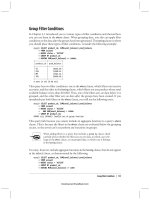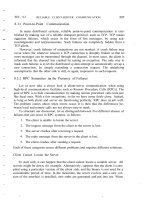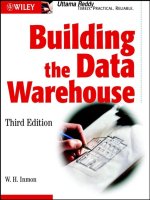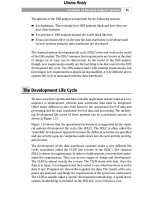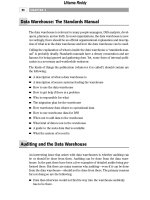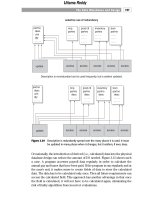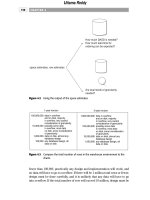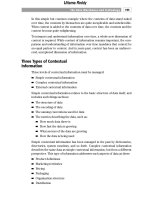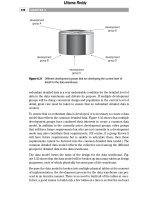Building the Data Warehouse Third Edition phần 6 ppt
Bạn đang xem bản rút gọn của tài liệu. Xem và tải ngay bản đầy đủ của tài liệu tại đây (478.83 KB, 43 trang )
In this simple but common example where the contents of data stand naked
over time, the contents by themselves are quite inexplicable and unbelievable.
When context is added to the contents of data over time, the contents and the
context become quite enlightening.
To interpret and understand information over time, a whole new dimension of
context is required. While content of information remains important, the com-
parison and understanding of information over time mandates that context be
an equal partner to content. And in years past, context has been an undiscov-
ered, unexplored dimension of information.
Three Types of Contextual
Information
Three levels of contextual information must be managed:
■■
Simple contextual information
■■
Complex contextual information
■■
External contextual information
Simple contextual information relates to the basic structure of data itself, and
includes such things as these:
■■
The structure of data
■■
The encoding of data
■■
The naming conventions used for data
■■
The metrics describing the data, such as:
■■
How much data there is
■■
How fast the data is growing
■■
What sectors of the data are growing
■■
How the data is being used
Simple contextual information has been managed in the past by dictionaries,
directories, system monitors, and so forth. Complex contextual information
describes the same data as simple contextual information, but from a different
perspective. This type of information addresses such aspects of data as these:
■■
Product definitions
■■
Marketing territories
■■
Pricing
■■
Packaging
■■
Organization structure
■■
Distribution
The Data Warehouse and Technology
193
Uttama Reddy
Complex contextual information is some of the most useful and, at the same
time, some of the most elusive information there is to capture. It is elusive
because it is taken for granted and is in the background. It is so basic that no
one thinks to define what it is or how it changes over time. And yet, in the long
run, complex contextual information plays an extremely important role in
understanding and interpreting information over time.
External contextual information is information outside the corporation that
nevertheless plays an important role in understanding information over time.
Some examples of external contextual information include the following:
■■
Economic forecasts:
■■
Inflation
■■
Financial trends
■■
Taxation
■■
Economic growth
■■
Political information
■■
Competitive information
■■
Technological advancements
■■
Consumer demographic movements
External contextual information says nothing directly about a company but
says everything about the universe in which the company must work and com-
pete. External contextual information is interesting both in terms of its imme-
diate manifestation and its changes over time. As with complex contextual
information, there is very little organized attempt to capture and measure this
information. It is so large and so obvious that it is taken for granted, and it is
quickly forgotten and difficult to reconstruct when needed.
Capturing and Managing
Contextual Information
Complex and external contextual types of information are hard to capture and
quantify because they are so unstructured. Compared to simple contextual
information, external and complex contextual types of information are very
amorphous. Another mitigating factor is that contextual information changes
quickly. What is relevant one minute is passé the next. It is this constant flux
and the amorphous state of external and complex contextual information that
makes these types of information so hard to systematize.
CHAPTER 5
194
Uttama Reddy
Looking at the Past
One can argue that the information systems profession has had contextual
information in the past. Dictionaries, repositories, directories, and libraries are
all attempts at the management of simple contextual information. For all the
good intentions, there have been some notable limitations in these attempts
that have greatly short-circuited their effectiveness. Some of these shortcom-
ings are as follows:
■■
The information management attempts were aimed at the information sys-
tems developer, not the end user. As such, there was very little visibility to
the end user. Consequently, the end user had little enthusiasm or support
for something that was not apparent.
■■
Attempts at contextual management were passive. A developer could opt
to use or not use the contextual information management facilities. Many
chose to work around those facilities.
■■
Attempts at contextual information management were in many cases
removed from the development effort. In case after case, application devel-
opment was done in 1965, and the data dictionary was done in 1985. By
1985, there were no more development dollars. Furthermore, the people
who could have helped the most in organizing and defining simple contex-
tual information were long gone to other jobs or companies.
■■
Attempts to manage contextual information were limited to only simple
contextual information. No attempt was made to capture or manage exter-
nal or complex contextual information.
Refreshing the Data Warehouse
Once the data warehouse is built, attention shifts from the building of the data
warehouse to its day-to-day operations. Inevitably, the discovery is made that
the cost of operating and maintaining a data warehouse is high, and the volume
of data in the warehouse is growing faster than anyone had predicted. The
widespread and unpredictable usage of the data warehouse by the end-user
DSS analyst causes contention on the server managing the warehouse. Yet the
largest unexpected expense associated with the operation of the data ware-
house is the periodic refreshment of legacy data. What starts out as an almost
incidental expense quickly turns very significant.
The first step most organizations take in the refreshment of data warehouse
data is to read the old legacy databases. For some kinds of processing and
under certain circumstances, directly reading the older legacy files is the only
The Data Warehouse and Technology
195
Uttama Reddy
way refreshment can be achieved, for instance, when data must be read from
different legacy sources to form a single unit that is to go into the data ware-
house. In addition, when a transaction has caused the simultaneous update of
multiple legacy files, a direct read of the legacy data may be the only way to
refresh the warehouse.
As a general-purpose strategy, however, repeated and direct reads of the
legacy data are a very costly. The expense of direct legacy database reads
mounts in two ways. First, the legacy DBMS must be online and active during
the read process. The window of opportunity for lengthy sequential process-
ing for the legacy environment is always limited. Stretching the window to
refresh the data warehouse is never welcome. Second, the same legacy data is
needlessly passed many times. The refreshment scan must process 100 per-
cent of a legacy file when only 1 or 2 percent of the legacy file is actually
needed. This gross waste of resources occurs each time the refreshment
process is done. Because of these inefficiencies, repeatedly and directly read-
ing the legacy data for refreshment is a strategy that has limited usefulness
and applicability.
A much more appealing approach is to trap the data in the legacy environment
as it is being updated. By trapping the data, full table scans of the legacy envi-
ronment are unnecessary when the data warehouse must be refreshed. In addi-
tion, because the data can be trapped as it is being updated, there is no need to
have the legacy DBMS online for a long sequential scan. Instead, the trapped
data can be processed offline.
Two basic techniques are used to trapp data as update is occurring in the legacy
operational environment. One technique is called data replication; the other is
called change data capture, where the changes that have occurred are pulled
out of log or journal tapes created during online update. Each approach has its
pros and cons.
Replication requires that the data to be trapped be identified prior to the
update. Then, as update occurs, the data is trapped. A trigger is set that causes
the update activity to be captured. One of the advantages of replication is that
the process of trapping can be selectively controlled. Only the data that needs
to be captured is, in fact, captured. Another advantage of replication is that the
format of the data is “clean” and well defined. The content and structure of the
data that has been trapped are well documented and readily understandable to
the programmer. The disadvantages of replication are that extra I/O is incurred
as a result of trapping the data and because of the unstable, ever-changing
nature of the data warehouse, the system requires constant attention to the def-
inition of the parameters and triggers that control trapping. The amount of I/O
required is usually nontrivial. Furthermore, the I/O that is consumed is taken
CHAPTER 5
196
Uttama Reddy
out of the middle of the high-performance day, at the time when the system can
least afford it.
The second approach to efficient refreshment is changed data capture (CDC).
One approach to CDC is to use the log tape to capture and identify the changes
that have occurred throughout the online day. In this approach, the log or jour-
nal tape is read. Reading a log tape is no small matter, however. Many obstacles
are in the way, including the following:
■■
The log tape contains much extraneous data.
■■
The log tape format is often arcane.
■■
The log tape contains spanned records.
■■
The log tape often contains addresses instead of data values.
■■
The log tape reflects the idiosyncracies of the DBMS and varies widely
from one DBMS to another.
The main obstacle in CDC, then, is that of reading and making sense out of the
log tape. But once that obstacle is passed, there are some very attractive bene-
fits to using the log for data warehouse refreshment. The first advantage is effi-
ciency. Unlike replication processing, log tape processing requires no extra I/O.
The log tape will be written regardless of whether it will be used for data ware-
house refreshment. Therefore, no incremental I/O is necessary. The second
advantage is that the log tape captures all update processing. There is no need
to go back and redefine parameters when a change is made to the data ware-
house or the legacy systems environment. The log tape is as basic and stable as
you can get.
There is a second approach to CDC: lift the changed data out of the DBMS
buffers as change occurs. In this approach the change is reflected immediately.
So reading a log tape becomes unnecessary, and there is a time-savings from the
moment a change occurs to when it is reflected in the warehouse. However,
because more online resources are required, including system software sensi-
tive to changes, there is a performance impact. Still, this direct buffer approach
can handle large amounts of processing at a very high speed.
The progression described here mimics the mindset of organizations as they
mature in their understanding and operation of the data warehouse. First, the
organization reads legacy databases directly to refresh its data warehouse.
Then it tries replication. Finally, the economics and the efficiencies of opera-
tion lead it to CDC as the primary means to refresh the data warehouse. Along
the way it is discovered that a few files require a direct read. Other files
work best with replication. But for industrial-strength, full-bore, general-
The Data Warehouse and Technology
197
Uttama Reddy
purpose data warehouse refreshment, CDC looms as the long-term final
approach to data warehouse refreshment.
Testing
In the classical operational environment, two parallel environments are set
up—one for production and one for testing. The production environment is
where live processing occurs. The testing environment is where programmers
test out new programs and changes to existing programs. The idea is that it is
safer when programmers have a chance to see if the code they have created will
work before it is allowed into the live online environment.
It is very unusual to find a similar test environment in the world of the data
warehouse, for the following reasons:
■■
Data warehouses are so large that a corporation has a hard time justifying
one of them, much less two of them.
■■
The nature of the development life cycle for the data warehouse is itera-
tive. For the most part, programs are run in a heuristic manner, not in a
repetitive manner. If a programmer gets something wrong in the data ware-
house environment (and programmers do all the time), the environment is
set up so that the programmer simply redoes it.
The data warehouse environment then is fundamentally different from the clas-
sical production environment because, under most circumstances, a test envi-
ronment is simply not needed.
Summary
Some technological features are required for satisfactory data warehouse pro-
cessing. These include a robust language interface, the support of compound
keys and variable-length data, and the abilities to do the following:
■■
Manage large amounts of data.
■■
Manage data on a diverse media.
■■
Easily index and monitor data.
■■
Interface with a wide number of technologies.
■■
Allow the programmer to place the data directly on the physical device.
■■
Store and access data in parallel.
■■
Have meta data control of the warehouse.
CHAPTER 5
198
TEAMFLY
Team-Fly
®
Uttama Reddy
■■
Efficiently load the warehouse.
■■
Efficiently use indexes.
■■
Store data in a compact way.
■■
Support compound keys.
■■
Selectively turn off the lock manager.
■■
Do index-only processing.
■■
Quickly restore from bulk storage.
Additionally, the data architect must recognize the differences between a trans-
action-based DBMS and a data warehouse-based DBMS. A transaction-based
DBMS focuses on the efficient execution of transactions and update. A data
warehouse-based DBMS focuses on efficient query processing and the handling
of a load and access workload.
Multidimensional OLAP technology is suited for data mart processing and not
data warehouse processing. When the data mart approach is used as a basis for
data warehousing, many problems become evident:
■■
The number of extract programs grows large.
■■
Each new multidimensional database must return to the legacy operational
environment for its own data.
■■
There is no basis for reconciliation of differences in analysis.
■■
A tremendous amount of redundant data among different multidimensional
DBMS environments exists.
Finally, meta data in the data warehouse environment plays a very different role
than meta data in the operational legacy environment.
The Data Warehouse and Technology
199
Uttama Reddy
Uttama Reddy
The Distributed Data
Warehouse
CHAPTER
6
M
ost organizations build and maintain a single centralized data warehouse envi-
ronment. This setup makes sense for many reasons:
■■
The data in the warehouse is integrated across the corporation, and an
integrated view is used only at headquarters.
■■
The corporation operates on a centralized business model.
■■
The volume of data in the data warehouse is such that a single centralized
repository of data makes sense.
■■
Even if data could be integrated, if it were dispersed across multiple local
sites, it would be cumbersome to access.
In short, the politics, the economics, and the technology greatly favor a single
centralized data warehouse. Still, in a few cases, a distributed data warehouse
makes sense, as we’ll see in this chapter.
201
Uttama Reddy
Types of Distributed Data Warehouses
The three types of distributed data warehouses are as follows:
■■
Business is distributed geographically or over multiple, differing product
lines. In this case, there is what can be called a local data warehouse and a
global data warehouse. The local data warehouse represents data and pro-
cessing at a remote site, and the global data warehouse represents that
part of the business that is integrated across the business.
■■
The data warehouse environment will hold a lot of data, and the volume of
data will be distributed over multiple processors. Logically there is a single
data warehouse, but physically there are many data warehouses that are all
tightly related but reside on separate processors. This configuration can be
called the technologically distributed data warehouse.
■■
The data warehouse environment grows up in an uncoordinated manner—
first one data warehouse appears, then another. The lack of coordination
of the growth of the different data warehouses is usually a result of politi-
cal and organizational differences. This case can be called the indepen-
dently evolving distributed data warehouse.
Each of these types of distributed data warehouse has its own concerns and
considerations, which we will examine in the following sections.
Local and Global Data Warehouses
When a corporation is spread around the world, information is needed both
locally and globally. The global needs for corporate information are met by a
central data warehouse where information is gathered. But there is also a need
for a separate data warehouse at each local organization—that is, in each coun-
try. In this case, a distributed data warehouse is needed. Data will exist both
centrally and in a distributed manner.
A second case for a local/global distributed data warehouse occurs when a large
corporation has many lines of business. Although there may be little or no busi-
ness integration among the different vertical lines of business, at the corporate
level—at least as far as finance is concerned—there is. The different lines of
business may not meet anywhere else but at the balance sheet, or there may be
considerable business integration, including such things as customers, prod-
ucts, vendors, and the like. In this scenario, a corporate centralized data ware-
house is supported by many different data warehouses for each line of business.
In some cases part of the data warehouse exists centrally (i.e., globally), and
other parts of the data warehouse exist in a distributed manner (i.e., locally).
CHAPTER 6
202
Uttama Reddy
To understand when a geographically or distributed business distributed data
warehouse makes sense, consider some basic topologies of processing.
Figure 6.1 shows a very common processing topology.
In Figure 6.1, all processing is done at the organization’s headquarters. If any
processing is done at the local geographically dispersed level, it is very basic,
involving, perhaps, a series of dumb terminals. In this type of topology it is very
unlikely that a distributed data warehouse will be necessary.
One step up the ladder in terms of sophistication of local processing is the case
where basic data and transaction capture activity occurs at the local level, as
shown in Figure 6.2. In this scenario, some small amount of very basic process-
ing occurs at the local level. Once the transactions that have occurred locally
are captured, they are shipped to a central location for further processing.
The Distributed Data Warehouse
203
operational
processing
site A
site A
site A
site C
site A
site B
site A
hdqtrs
Figure 6.1 A topology of processing representative of many enterprises.
operational
processing
capture
activity
capture
activity
capture
activity
site A
site A
site A
site C
site A
site B
site A
hdqtrs
Figure 6.2 In some cases, very basic activity is done at the site level.
Uttama Reddy
Under this simple topology it is very unlikely that a distributed data warehouse
is needed. From a business standpoint, no great amount of business occurs
locally, and decisions made locally do not warrant a data warehouse.
Now, contrast the processing topology shown in Figure 6.3 with the previous
two. In Figure 6.3, a fair amount of processing occurs at the local level. Sales
are made. Money is collected. Bills are paid locally. As far as operational pro-
cessing is concerned, the local sites are autonomous. Only on occasion and for
certain types of processing will data and activities be sent to the central orga-
nization. A central corporate balance sheet is kept. It is for this type of organi-
zation that some form of distributed data warehouse makes sense.
And then, of course, there is the even larger case where much processing
occurs at the local level. Products are made. Sales forces are hired. Marketing
is done. An entire mini-corporation is set up locally. Of course, the local corpo-
rations report to the same balance sheet as all other branches of the corpora-
tion. But, at the end of the day, the local organizations are effectively their own
company, and there is little business integration of data across the corporation.
In this case, a full-scale data warehouse at the local level is needed.
Just as there are many different kinds of distributed business models, there is
more than one type of local/global distributed data warehouse, as will be dis-
cussed. It is a mistake to think that the model for the local/global distributed
data warehouse is a binary proposition. Instead, there are degrees of distrib-
uted data warehouse.
CHAPTER 6
204
global
operational
processing
local
operational
processing
local
operational
processing
local
operational
processing
site A
site A
site A
site C
site A
site B
site A
hdqtrs
Figure 6.3 At the other end of the spectrum of the distributed data warehouse, much of
the operational processing is done locally.
Uttama Reddy
Most organizations that do not have a great deal of local autonomy and pro-
cessing have a central data warehouse, as shown in Figure 6.4.
The Local Data Warehouse
A form of data warehouse, known as a local data warehouse, contains data that
is of interest only to the local level. There might be a local data warehouse for
Brazil, one for France, and one for Hong Kong. Or there might be a local data
warehouse for car parts, motorcycles, and heavy trucks. Each local data ware-
house has its own technology, its own data, its own processor, and so forth. Fig-
ure 6.5 shows a simple example of a series of local data warehouses.
In Figure 6.5, a local data warehouse exists for different geographical regions
or for different technical communities. The local data warehouse serves the
same function that any other data warehouse serves, except that the scope of
the data warehouse is local. For example, the data warehouse for Brazil does
not have any information about business activities in France. Or the data ware-
house for car parts does not have any data about motorcycles. In other words,
the local data warehouse contains data that is historical in nature and is inte-
grated within the local site. There is no coordination of data or structure of data
from one local data warehouse to another.
The Distributed Data Warehouse
205
operational
processing
site A
site A
site A
site C
site A
site B
site A
hdqtrs
data
warehouse
Figure 6.4 Most organizations have a centrally controlled, centrally housed data ware-
house.
Uttama Reddy
CHAPTER 6
206
operational
processing
site A
site A
site A
site C
site A
site B
site A
hdqtrs
global
data
warehouse
local
data
warehouse
local
data
warehouse
local
data
warehouse
Europe
Africa
Asia
USA
local
data
warehouse
operational
processing
site A
site A
site A
site C
site A
site B
site A
hdqtrs
global
data
warehouse
local
data
warehouse
local
data
warehouse
local
data
warehouse
all DEC
all Tandem
all IBM
USA
local
data
warehouse
mixed IBM,
DEC,
Tandem
Figure 6.5 Some circumstances in which you might want to create a two-tiered level of
data warehouse.
Uttama Reddy
The Global Data Warehouse
Of course, there can also be a global data warehouse, as shown in Figure 6.6.
The global data warehouse has as its scope the corporation or the enterprise,
while each of the local data warehouses within the corporation has as its scope
the local site that it serves. For example, the data warehouse in Brazil does not
coordinate or share data with the data warehouse in France, but the local data
warehouse in Brazil does share data with the corporate headquarters data
warehouse in Chicago. Or the local data warehouse for car parts does not share
data with the local data warehouse for motorcycles, but it does share data with
the corporate data warehouse in Detroit. The scope of the global data ware-
house is the business that is integrated across the corporation. In some cases,
there is considerable corporate integrated data; in other cases, there is very lit-
tle. The global data warehouse contains historical data, as do the local data
warehouses. The source of the data for the local data warehouses is shown in
Figure 6.7, where we see that each local data warehouse is fed by its own oper-
ational systems. The source of data for the corporate global data warehouse is
the local data warehouses, or in some cases, a direct update can go into the
global data warehouse.
The Distributed Data Warehouse
207
site A
site A
site A
site C
site A
site B
site A
hdqtrs
local
data
warehouse
local
operational
processing
local
data
warehouse
local
operational
processing
local
data
warehouse
local
operational
processing
local
data
warehouse
local
operational
processing
global
data
warehouse
Figure 6.6 What a typical distributed data warehouse might look like.
Uttama Reddy
The global data warehouse contains information that must be integrated at the
corporate level. In many cases, this consists only of financial information. In
other cases, this may mean integration of customer information, product infor-
mation, and so on. While a considerable amount of information will be peculiar
to and useful to only the local level, other corporate common information will
need to be shared and managed corporately. The global data warehouse con-
tains the data that needs to be managed globally.
An interesting issue is commonality of data among the different local data
warehouses. Figure 6.8 shows that each local warehouse has its own unique
structure and content of data. In Brazil there may be much information about
the transport of goods up and down the Amazon. This information is of no use
in Hong Kong and France. Conversely, information might be stored in the
French data warehouse about the trade unions in France and about trade under
the Euro that is of little interest in Hong Kong or Brazil.
Or in the case of the car parts data warehouse, an interest might be shared in
spark plugs among the car parts, motorcycle, and heavy trucks data ware-
houses, but the tires used by the motorcycle division are not of interest to the
CHAPTER 6
208
site A
site A
site A
site C
site A
site B
site A
hdqtrs
local
data
warehouse
local
operational
processing
local
data
warehouse
local
operational
processing
local
data
warehouse
local
operational
processing
local
data
warehouse
local
operational
processing
Figure 6.7 The flow of data from the local operational environment to the local data
warehouse.
TEAMFLY
Team-Fly
®
Uttama Reddy
heavy trucks or the car parts division. There is then both commonality and
uniqueness among local data warehouses.
Any intersection or commonality of data from one local data warehouse to
another is purely coincidental. There is no coordination whatsoever of data,
processing structure, or definition between the local data warehouses shown in
Figure 6.8.
However, it is reasonable to assume that a corporation will have at least some
natural intersections of data from one local site to another. If such an intersec-
tion exists, it is best contained in a global data warehouse. Figure 6.9 shows
The Distributed Data Warehouse
209
site A
site A
site A
site C
site A
site B
site A
hdqtrs
local
data
warehouse
local
operational
processing
local
data
warehouse
local
operational
processing
local
data
warehouse
local
operational
processing
local
data
warehouse
local
operational
processing
Figure 6.8 The structure and content of the local data warehouses are very different.
Uttama Reddy
that the global data warehouse is fed from existing local operational systems.
The common data may be financial information, customer information, parts
vendors, and so forth.
Intersection of Global and Local Data
Figure 6.9 shows that data is being fed from the local data warehouse environ-
ment to the global data warehouse environment. The data may be carried in
both warehouses, and a simple transformation of data may occur as the data is
placed in the global data warehouse. For example, one local data warehouse
may carry its information in the Hong Kong dollar but convert to the U.S. dollar
on entering the global data warehouse. Or the French data warehouse may
carry parts specifications in metric in the French data warehouse but convert
metric to English measurements on entering the global data warehouse.
CHAPTER 6
210
site A
site A
site A
site C
site A
site B
site A
hdqtrs
local
data
warehouse
local
operational
processing
local
data
warehouse
local
operational
processing
local
data
warehouse
local
operational
processing
local
data
warehouse
local
operational
processing
global data
warehouse
Figure 6.9 The global data warehouse is fed by the outlying operational systems.
Uttama Reddy
The global data warehouse contains data that is common across the corpora-
tion and data that is integrated. Central to the success and usability of the dis-
tributed data warehouse environment is the mapping of data from the local
operational systems to the data structure of the global data warehouse, as seen
in Figure 6.10. This mapping determines which data goes into the global data
warehouse, the structure of the data, and any conversions that must be done.
The mapping is the most important part of the design of the global data ware-
house, and it will be different for each local data warehouse. For instance, the
way that the Hong Kong data maps into the global data warehouse is different
from how the Brazil data maps into the global data warehouse, which is yet dif-
ferent from how the French map their data into the global data warehouse. It is
in the mapping to the global data warehouse that the differences in local busi-
ness practices are accounted for.
The mapping of local data into global data is easily the most difficult aspect of
building the global data warehouse.
Figure 6.10 shows that for some types of data there is a common structure of
data for the global data warehouse. The common data structure encompasses
and defines all common data across the corporation, but there is a different
mapping of data from each local site into the global data warehouse. In other
words, the global data warehouse is designed and defined centrally based on
the definition and identification of common corporate data, but the mapping of
the data from existing local operational systems is a choice made by the local
designer and developer.
It is entirely likely that the mapping from local operational systems into global
data warehouse systems will not be done as precisely as possible the first time.
Over time, as feedback from the user is accumulated, the mapping at the local
level improves. If ever there were a case for iterative development of a data
warehouse, it is in the creation and solidification of global data based on the
local mapping.
A variation of the local/global data warehouse structure that has been dis-
cussed is to allow a global data warehouse “staging” area to be kept at the local
level. Figure 6.11 shows that each local area stages global warehouse data
before passing the data to the central location. For example, say that in France
are two data warehouses—one a local data warehouse used for French deci-
sions. In this data warehouse all transactions are stored in the French franc. In
addition, there is a “staging area” in France, where transactions are stored in
U.S. dollars. The French are free to use either their own local data warehouse
or the staging area for decisions. In many circumstances, this approach may
be technologically mandatory. An important issue is associated with this
approach: Should the locally staged global data warehouse be emptied after the
The Distributed Data Warehouse
211
Uttama Reddy
data that is staged inside of it is transferred to the global level? If the data is not
deleted locally, redundant data will exist. Under certain conditions, some
amount of redundancy may be called for. This issue must be decided and poli-
cies and procedures put into place.
CHAPTER 6
212
site A
site A
local
operational
processing
site A
site C
local
operational
processing
site A
site B
local
operational
processing
site A
hdqtrs
local
operational
processing
global
data
warehouse
mapping into the global
data structure
Figure 6.10 There is a common structure for the global data warehouse. Each local site
maps into the common structure differently.
Uttama Reddy
For example, the Brazilian data warehouse may create a staging area for its
data based on American dollars and the product descriptions that are used
globally. In the background the Brazilians may have their own data warehouse
in Brazilian currency and the product descriptions as they are known in Brazil.
The Brazilians may use both their own data warehouse and the staged data
warehouse for reporting and analysis.
The Distributed Data Warehouse
213
site A
site A
local
data
warehouse
local
operational
processing
global
data warehouse
(staging area)
site A
site C
local
data
warehouse
local
operational
processing
global
data warehouse
(staging area)
site A
site B
local
data
warehouse
local
operational
processing
global
data warehouse
(staging area)
site A
hdqtrs
local
data
warehouse
local
operational
processing
global
data warehouse
Figure 6.11 The global data warehouse may be staged at the local level, then passed to
the global data warehouse at the headquarters level.
Uttama Reddy
Though any of several subject areas may be candidates for the first global data
warehouse development effort, many corporations begin with corporate finance.
Finance is a good starting point for the following reasons:
■■
It is relatively stable.
■■
It enjoys high visibility.
■■
It is only a fraction of the business of the organization (except, of course,
for organizations whose business is finance).
■■
It is always at the nerve center of the organization.
■■
It entails only a modicum of data.
In the case of the global warehouse being discussed, the Brazilian, the French,
and the Hong Kong data warehouses would all participate in the building of a
corporatewide financial data warehouse. There would be lots of other data in
the operations of the Brazilian, French, and Hong Kong business units, but only
the financial information would flow into the global data warehouse.
Because the global data warehouse does not fit the classical structure of a data
warehouse as far as the levels of data are concerned, when building the global
data warehouse, one must recognize that there will be some anomalies. One
such anomaly is that the detailed data (or, at least, the source of the detailed
data) resides at the local level, while the lightly summarized data resides at the
centralized global level. For example, suppose that the headquarters of a com-
pany is in New York and it has outlying offices in Texas, California, and Illinois.
The details of sales and finance are managed independently and at a detailed
level in Texas, California, and Illinois. The data model is passed to the outlying
regions, and the needed corporate data is translated into the form that is nec-
essary to achieve integration across the corporation. Upon having made the
translation at the local level, the data is transmitted to New York. The raw,
untranslated detail still resides at the local level. Only the transformed, lightly
summarized data is passed to headquarters. This is a variation on the theme of
the classical data warehouse structure.
Redundancy
One of the issues of a global data warehouse and its supporting local data ware-
houses is redundancy or overlap of data. Figure 6.12 shows that, as a policy,
only minimal redundant data exists between the local levels and the global lev-
els of data (and in this regard, it matters not whether global data is stored
locally in a staging area or locally). On occasion, some detailed data will pass
through to the global data warehouse untouched by any transformation or con-
version. In this case, a small overlap of data from the global data warehouse to
CHAPTER 6
214
Uttama Reddy
the local data warehouse will occur. For example, suppose a transaction occurs
in France for US$10,000. That transaction may pass through to the global data
warehouse untouched.
On the other hand, most data passes through some form of conversion, trans-
formation, reclassification, or summarization as it passes from the local data
warehouse to the data warehouse. In this case, there is—strictly speaking—no
redundancy of data between the two environments. For example, suppose that
a HK$175,000 transaction is recorded in Hong Kong. The transaction may be
broken apart into several smaller transactions, the dollar amount may be con-
verted, the transaction may be combined with other transactions, and so forth.
In this case, there is certainly a relationship between the detailed data found in
the local data warehouse and the data found in the global data warehouse. But
there is no redundancy of data between the two environments.
A massive amount of redundancy of data between the local and the global data
warehouse environments indicates that the scopes of the different warehouses
probably have not been defined properly. When massive redundancy of data
exists between the local and the global data warehouse environments, it is only
a matter of time before spider web systems start to appear. With the appearance
of such systems come many problems—reconciliation of inconsistent results,
inability to create new systems easily, costs of operation, and so forth. For this
reason, it should be a matter of policy that global data and local data be mutu-
ally exclusive with the exception of very small amounts of data that incidentally
overlap between the two environments.
The Distributed Data Warehouse
215
site A
site A
local
data
warehouse
local
operational
processing
global
data warehouse
(staging area)
site A
hdqtrs
local
data
warehouse
local
operational
processing
global
data warehouse
(staging area)
mutually
exclusive
mutually
exclusive
Figure 6.12 Data can exist in either the local data warehouse or the global data ware-
house, but not both.
Uttama Reddy
Access of Local and Global Data
In line with policies required to manage and structure the local and the global
data warehouses is the issue of access of data. At first, this issue seems to be
almost trivial. The obvious policy is that anyone should be able to get at any
data. Some important ramifications and nuances come into play, however.
Figure 6.13 shows that some local sites are accessing global data. Depending on
what is being asked for, this may or may not be an appropriate use of data ware-
house data. For example, an analyst in Brazil may be analyzing how Brazilian
revenues compare to total corporate revenues. Or a person in France may be
looking at total corporate profitability. If the intent of the local analysis is to
improve local business, the access of global data at the local level is probably a
good policy. If the global data is being used informationally, on a one-time-only
basis, and to improve local business practices, the access of global data at the
local level is probably acceptable.
As a principle, local data should be used locally and global data should be used
globally. The question must be raised, then, why is global analysis being done
locally? For example, suppose a person in Hong Kong is comparing total cor-
porate profitability with that of another corporation. There is nothing wrong
per se with this analysis, except that this sort of global analysis is best per-
formed at the headquarters level. The question must be asked—what if the per-
son in Hong Kong finds that globally the corporation is not competing well with
CHAPTER 6
216
site A
hdqtrs
local
data
warehouse
local
operational
processing
global
data warehouse
site A
site A
site A
site C
site A
site B
Figure 6.13 An important issue to be resolved is whether local sites should be access-
ing the global data warehouse.
Uttama Reddy
other corporations? What is the person in Hong Kong going to do with that
information? The person may have input into global decisions, but he or she is
not in a position to effect a such a decision. Therefore, it is questionable
whether a local business analyst should be looking at global data for any other
purpose than that of improving local business practices. As a rule, the local
business analyst should be satisfied using local data.
Another issue is the routing of requests for information into the architected
information environment. When only a single central data warehouse existed,
the source of a request for information was not much of an issue. But when data
is distributed over a complex landscape, such as a distributed data warehouse
landscape, as shown in Figure 6.14, there is the consideration of ensuring the
request originated from the appropriate place.
For example, asking a local site to determine total corporate salaries is inap-
propriate, as is asking the central data warehouse group what a contractor was
paid last month at a particular site for a particular service. With local and global
data there is the issue of origin of request, something not encountered in the
simple centralized data warehouse environment.
Another important issue of local/global distributed data warehousing is the
transfer of data from the local data warehouse to the global data warehouse.
There are many facets to this issue:
■■
How frequently will the transfer of data from the local environment to the
global environment be made? Daily? Weekly? Monthly? The rate of transfer
depends on a combination of factors. How quickly is the data needed in the
global data warehouse? How much activity has occurred at the local level?
What volume of data is being transported?
■■
Is the transportation of the data from the local environment to the global
data warehouse across national lines legal? Some countries have Dracon-
ian laws that prevent the movement of certain kinds of data across their
national boundaries.
■■
What network will be used to transport the data from the local environ-
ment to the global environment? Is the Internet safe enough? Reliable
enough? Can the Internet safely transport enough data? What is the backup
strategy? What safeguards are in place to determine if all of the data has
been passed?
■■
What safeguards are in place to determine whether data is being hacked
during transport from the local environment to the global environment?
■■
What window of processing is open for transport of data from the local envi-
ronment to the global environment? Will transportation have to be done dur-
ing the hours when processing against the data warehouse will be heavy?
The Distributed Data Warehouse
217
Uttama Reddy
